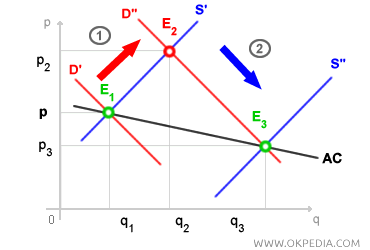Decreasing Cost Industry
A decreasing cost industry describes a long-term market equilibrium where average costs decline as production levels increase. As production rises, the average production cost drops, which in turn lowers the market price of the product. In a graphical representation, the industry’s output is plotted on the horizontal axis, while the product price is shown on the vertical axis. The average cost curve (long-term supply curve) slopes downward, indicating a decrease.

Initially, the market equilibrium is at point E1, where short-term demand (D') and supply (S') are balanced, and the price P1 equals the average cost (AC). As market demand increases, the demand curve shifts to the right (phase 1), establishing a new equilibrium at point E2. However, E2 represents only a temporary, short-term balance. In the long term, the number of firms in the market can fluctuate, adjusting based on the presence or absence of extra profits. The equilibrium at E2 results in an extra profit, which is the difference between the new market price (P2) and the average production cost (AC), benefiting the existing firms in the industry. This extra profit attracts new competitors to enter the market, leading to an increase in overall production. The supply curve (S') shifts further to the right (phase 2). This shift continues until it reaches equilibrium at point E3, where demand (D") matches supply (S"), and the market price P3 equals the average cost (AC). With average costs decreasing, the new equilibrium price P3 is lower than the initial price P1.
